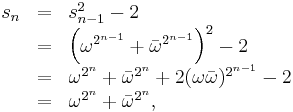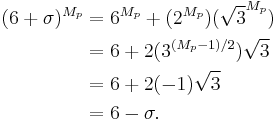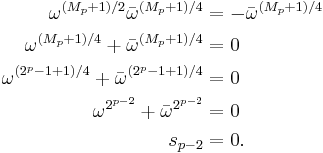Lucas–Lehmer primality test
In mathematics, the Lucas–Lehmer test (LLT) is a primality test for Mersenne numbers. The test was originally developed by Édouard Lucas in 1856,[1] and subsequently improved by Lucas in 1878 and Derrick Henry Lehmer in the 1930s.
Contents |
The test
The Lucas–Lehmer test works as follows. Let Mp = 2p − 1 be the Mersenne number to test with p an odd prime (because p is exponentially smaller than Mp, we can use a simple algorithm like trial division for establishing its primality). Define a sequence {s i } for all i ≥ 0 by
The first few terms of this sequence are 4, 14, 194, 37634, ... (sequence A003010 in OEIS). Then Mp is prime iff
The number sp − 2 mod Mp is called the Lucas–Lehmer residue of p. (Some authors equivalently set s1 = 4 and test sp−1 mod Mp). In pseudocode, the test might be written:
// Determine if Mp = 2p − 1 is prime
Lucas–Lehmer(p)
var s = 4
var M = 2p − 1
repeat p − 2 times:
s = ((s × s) − 2) mod M
if s = 0 return PRIME else return COMPOSITE
By performing the mod M at each iteration, we ensure that all intermediate results are at most p bits (otherwise the number of bits would double each iteration). It is exactly the same strategy employed in modular exponentiation.
Time complexity
In the algorithm as written above, there are two expensive operations during each iteration: the multiplication s × s, and the mod M operation. The mod M operation can be made particularly efficient on standard binary computers by observing the following simple property:
In other words, if we take the least significant n bits of k, and add the remaining bits of k, and then do this repeatedly until at most n bits remain, we can compute the remainder after dividing k by the Mersenne number 2n−1 without using division. For example:
| 916 mod 25−1 | = | 11100101002 mod 25−1 |
| = | 111002 + 101002 mod 25−1 | |
| = | 1100002 mod 25−1 | |
| = | 12 + 100002 mod 25−1 | |
| = | 100012 mod 25−1 | |
| = | 100012 | |
| = | 17. |
Moreover, since s × s will never exceed M2 < 22p, this simple technique converges in at most 2 p-bit additions, which can be done in linear time. As a small exceptional case, the above algorithm may produce 2n−1 for a multiple of the modulus, rather than the correct value of zero; this should be accounted for.
With the modulus out of the way, the asymptotic complexity of the algorithm depends only on the multiplication algorithm used to square s at each step. The simple "grade-school" algorithm for multiplication requires O(p2) bit-level or word-level operations to square a p-bit number, and since we do this O(p) times, the total time complexity is O(p3). A more efficient multiplication method, the Schönhage–Strassen algorithm based on the Fast Fourier transform, requires O(p log p log log p) time to square a p-bit number, reducing the complexity to O(p2 log p log log p) or Õ(p2).[2]. Currently the most efficient known multiplication algorithm, Fürer's algorithm, needs  time to multiply two p-bit numbers.
time to multiply two p-bit numbers.
By comparison, the most efficient randomized primality test for general integers, the Miller–Rabin primality test, takes O(k p2 log p log log p) bit operations using FFT multiplication for a p-digit number (here p can be any natural number, not necessarily a prime), where k is the number of iterations and is related to the error rate. So it is in the same complexity class as the Lucas-Lehmer test for constant k. But in practice the cost of doing many iterations and other differences leads to worse performance for Miller–Rabin. The most efficient deterministic primality test for general integers, the AKS primality test, requires Õ(p6) bit operations in its best known variant and is dramatically slower in practice.
Examples
Suppose we wish to verify that M3 = 7 is prime using the Lucas–Lehmer test. We start out with s set to 4 and then update it 3−2 = 1 time, taking the results mod 7:
- s ← ((4 × 4) − 2) mod 7 = 0
Because we end with s set to zero, M3 is prime.
On the other hand, M11 = 2047 = 23 × 89 is not prime. To show this, we start with s set to 4 and update it 11−2 = 9 times, taking the results mod 2047:
- s ← ((4 × 4) − 2) mod 2047 = 14
- s ← ((14 × 14) − 2) mod 2047 = 194
- s ← ((194 × 194) − 2) mod 2047 = 788
- s ← ((788 × 788) − 2) mod 2047 = 701
- s ← ((701 × 701) − 2) mod 2047 = 119
- s ← ((119 × 119) − 2) mod 2047 = 1877
- s ← ((1877 × 1877) − 2) mod 2047 = 240
- s ← ((240 × 240) − 2) mod 2047 = 282
- s ← ((282 × 282) − 2) mod 2047 = 1736
Because s is not zero, M11=2047 is not prime. Notice that we learn nothing about the factors of 2047, only its Lucas–Lehmer residue, 1736.
Proof of correctness
Lehmer's original proof of the correctness of this test is complex, so we'll depend upon more recent refinements. Recall the definition:
Then our theorem is that Mp is prime iff 
We begin by noting that  is a recurrence relation with a closed-form solution. Define
is a recurrence relation with a closed-form solution. Define  and
and  ; then we can verify by induction that
; then we can verify by induction that  for all i:
for all i:
where the last step follows from  . We will use this in both parts.
. We will use this in both parts.
Sufficiency
In this direction we wish to show that  implies that
implies that  is prime. We relate a straightforward proof exploiting elementary group theory given by J. W. Bruce[3] as related by Jason Wojciechowski.[4]
is prime. We relate a straightforward proof exploiting elementary group theory given by J. W. Bruce[3] as related by Jason Wojciechowski.[4]
Suppose  . Then
. Then  for some integer k, and:
for some integer k, and:
Now suppose Mp is composite, and let q be the smallest prime factor of Mp. Since Mersenne numbers are odd, we have q > 2. Define the set  with q2 elements, where
with q2 elements, where  is the integers mod q, a finite field (in the language of ring theory X is the quotient of the univariate polynomial ring
is the integers mod q, a finite field (in the language of ring theory X is the quotient of the univariate polynomial ring ![\mathbb{Z}_q[T]](/2012-wikipedia_en_all_nopic_01_2012/I/77c3177c1da9acf965c3b4eeb48f16b1.png) by the ideal generated by
by the ideal generated by  ). The multiplication operation in
). The multiplication operation in  is defined by:
is defined by:
Since q > 2,  and
and  are in
are in  (in fact
(in fact  are in X, but by abuse of language we identify
are in X, but by abuse of language we identify  and
and  with their images in X under the natural ring homomorphism from
with their images in X under the natural ring homomorphism from ![\mathbb{Z}[\sqrt{3}]](/2012-wikipedia_en_all_nopic_01_2012/I/0a0dd385cd558c3a6c6c6bbf39e426aa.png) to X which sends the square root of 3 to T). Any product of two numbers in X is in X, but it's not a group under multiplication because not every element x has an inverse y such that xy = 1 (in fact X is a ring and the set of non-zero elements of X is a group if and only if
to X which sends the square root of 3 to T). Any product of two numbers in X is in X, but it's not a group under multiplication because not every element x has an inverse y such that xy = 1 (in fact X is a ring and the set of non-zero elements of X is a group if and only if  does not contain a square root of 3). If we consider only the elements that have inverses, we get a group X* of size at most
does not contain a square root of 3). If we consider only the elements that have inverses, we get a group X* of size at most  (since 0 has no inverse).
(since 0 has no inverse).
Now, since  , and
, and  , we have
, we have  in X, which by equation (1) gives
in X, which by equation (1) gives  . Squaring both sides gives
. Squaring both sides gives  , showing that
, showing that  is invertible with inverse
is invertible with inverse  and so lies in X*, and moreover has an order dividing
and so lies in X*, and moreover has an order dividing  . In fact the order must equal
. In fact the order must equal  , since
, since  and so the order does not divide
and so the order does not divide  . Since the order of an element is at most the order (size) of the group, we conclude that
. Since the order of an element is at most the order (size) of the group, we conclude that  . But since q is the smallest prime factor of the composite
. But since q is the smallest prime factor of the composite  , we must have
, we must have  , yielding the contradiction
, yielding the contradiction  . So
. So  is prime.
is prime.
Necessity
In the other direction, we suppose  is prime and show
is prime and show  . We rely on a simplification of a proof by Öystein J. R. Ödseth.[5] First, notice that 3 is a quadratic non-residue mod Mp, since 2 p − 1 for odd p > 1 only takes on the value 7 mod 12, and so the Legendre symbol properties tell us
. We rely on a simplification of a proof by Öystein J. R. Ödseth.[5] First, notice that 3 is a quadratic non-residue mod Mp, since 2 p − 1 for odd p > 1 only takes on the value 7 mod 12, and so the Legendre symbol properties tell us  is −1. Euler's criterion then gives us:
is −1. Euler's criterion then gives us:
On the other hand, 2 is a quadratic residue mod  , since
, since  and so
and so  . Euler's criterion again gives:
. Euler's criterion again gives:
Next, define  , and define X* similarly as before as the multiplicative group of
, and define X* similarly as before as the multiplicative group of  . We will use the following lemmas:
. We will use the following lemmas:
(from Proofs of Fermat's little theorem#Proof_using_the_binomial_theorem)
for every integer a (Fermat's little theorem)
Then, in the group X* we have:
We chose  such that
such that  . Consequently, we can use this to compute
. Consequently, we can use this to compute  in the group X*:
in the group X*:
where we use the fact that
Since  , all that remains is to multiply both sides of this equation by
, all that remains is to multiply both sides of this equation by  and use
and use  :
:
Since sp−2 is an integer and is zero in X*, it is also zero mod Mp.
Applications
The Lucas–Lehmer test is the primality test used by the Great Internet Mersenne Prime Search to locate large primes, and has been successful in locating many of the largest primes known to date.[6] The test is considered valuable because it can provably test a very large number for primality within affordable time and, in contrast to the equivalently fast Pépin's test for any Fermat number, can be tried on a large search space of numbers with the required form before reaching computational limits.
See also
References
- ^ The Largest Known Prime by Year: A Brief History
- ^ Colquitt, W. N.; Welsh, L., Jr. (1991), "A New Mersenne Prime", Mathematics of Computation 56 (194): 867–870, "The use of the FFT speeds up the asymptotic time for the Lucas–Lehmer test for Mp from O(p3) to O(p2 log p log log p) bit operations."
- ^ J. W. Bruce (1993). "A Really Trivial Proof of the Lucas–Lehmer Test". The American Mathematical Monthly 100 (4): 370–371.
- ^ Jason Wojciechowski. Mersenne Primes, An Introduction and Overview. 2003.
- ^ Öystein J. R. Ödseth. A note on primality tests for N = h · 2n − 1. Department of Mathematics, University of Bergen.
- ^ What are Mersenne primes? How are they useful? Frequently Asked Questions. GIMPS Home Page.
- Crandall, Richard; Pomerance, Carl (2001), "Section 4.2.1: The Lucas–Lehmer test", Prime Numbers: A Computational Perspective (1st ed.), Berlin: Springer, p. 167–170, ISBN 0387947779
External links
- Weisstein, Eric W., "Lucas–Lehmer test" from MathWorld.
- GIMPS (The Great Internet Mersenne Prime Search)
- A proof of Lucas–Lehmer–Reix test (for Fermat numbers)
- Lucas–Lehmer test at MersenneWiki
|
|||||||||||||||||||||||||||||





![(a %2B b\sqrt{3})(c %2B d\sqrt{3}) = [(ac %2B 3bd) \hbox{ mod } q] %2B [(bc %2B ad) \hbox{ mod } q]\sqrt{3}.](/2012-wikipedia_en_all_nopic_01_2012/I/050f57aa63e90582e89514163a29e661.png)







